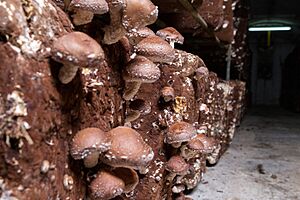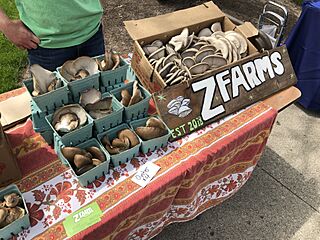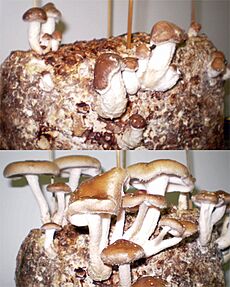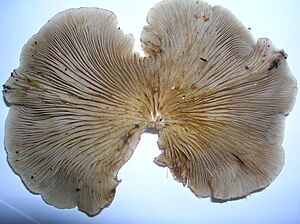Fungiculture facts for kids
Fungiculture is the special way of growing fungi, like mushrooms. People grow fungi for many reasons! They can become tasty food, helpful medicine, or even new construction materials. A place where mushrooms are grown for business is called a mushroom farm.
Did you know some animals also grow fungi? Leafcutter ants, termites, and even some beetles and snails are natural "fungi farmers" too!
Contents
How Mushrooms Grow
Mushrooms are different from plants. Plants use sunlight to make their own food through photosynthesis. But mushrooms get all their energy and building blocks from their surroundings. They break down materials in their growth medium, like tiny decomposers.
Even though they don't use sunlight for food, some fungi need light to know when to start growing their mushroom caps. Mushrooms like to grow in very humid places, almost 100% humidity, and their growing material needs to be quite moist.
Instead of seeds, mushrooms reproduce using tiny spores. These spores can easily pick up unwanted microorganisms from the air. This can stop the mushrooms from growing well.
To start growing, a special mushroom culture called mycelium is placed on a growing material, often sterilized grains like rye. This is called inoculation. These inoculated grains are known as spawn. Spores can also be used to start growth, but they are harder to work with and usually need a special lab.
Growing Techniques
All ways of growing mushrooms need the right mix of humidity, temperature, a good growing material (called substrate), and a starter (called inoculum or spawn). People grow mushrooms outdoors on logs or indoors in trays.
Growing on Outdoor Logs
For hundreds of years, people have grown mushrooms on logs placed outdoors. This method doesn't involve sterilizing the logs. Because the growth can depend on the season and be a bit unpredictable, less than 5% of mushrooms sold in stores are grown this way.
To grow mushrooms like shiitake or oyster mushrooms outdoors, tree logs are given the mushroom spawn. Then, they are left to grow naturally, just like in the wild. The mushrooms start to appear when the seasons change, or if the logs are briefly soaked in cool water.
In the Northeastern United States, shiitake mushrooms can grow on many hardwood logs, like oak or maple. Softwoods, like pine, are not good because their sap can stop the mushrooms from growing.
To grow shiitake mushrooms, people drill holes in 1-meter (3-foot) hardwood logs. They fill these holes with shiitake mycelium or spawn, then seal the holes with hot wax. The logs are then placed under trees and left for 12 to 15 months. After this time, the logs are soaked in water for 24 hours. About a week later, the shiitake mushrooms will start to grow and can be picked when they are ready.
Growing in Indoor Trays
Growing mushrooms indoors for selling started in caves in France. Caves were perfect because they had steady temperature and humidity all year. This indoor growing method allows farmers to control light, temperature, and humidity. It also keeps out unwanted germs and pests. This means mushrooms can be grown consistently, following a schedule. By the mid-1900s, large mushroom farms used special windowless buildings for this.
Growing in indoor trays is the most common way to grow mushrooms for business. It's easy to scale up and makes harvesting simpler.
The most common mushroom grown this way is the Agaricus bisporus, also known as the button mushroom. Its farming has several steps:
- Composting: Preparing the growing material.
- Pasteurization: Cleaning the material to reduce bad microbes.
- Spawning and growth: Adding the mushroom starter (spawn) and letting the mycelium grow.
- Casing: Adding a top layer to help mushroom "pins" form.
- Pinning: The first tiny mushrooms start to appear.
- Cropping: Harvesting the mushrooms.
Complete sterilization is not always needed. Often, a step called pasteurization is used. This allows some helpful tiny organisms to stay in the growing material.
The exact times and temperatures for growing mushrooms can change depending on the type of mushroom. The growing material and its shape also play a role.
The "pinning" stage is often the trickiest for growers. This is when a mix of carbon dioxide (CO2) levels, temperature, light, and humidity tells the mushroom to start forming its cap. Before pinning, the mushroom's mycelium looks like a fuzzy mass.
During the growth phase, the mycelium is often sealed in a bag, which traps the CO2 it produces. To make the mushrooms "pin," this bag is opened. This lowers the CO2 level to what is found in normal air, which helps the mushrooms start to form.
Indoor Oyster Mushroom Farming
Oyster mushroom farming is growing fast around the world. These mushrooms can grow on sterilized wheat, rice straw, or even used coffee grounds. They don't need a lot of space. This means they can produce a lot of mushrooms and profit from a small area. You can even grow oyster mushrooms indoors from kits, which usually come in a box with growing material and spores.
What Mushrooms Grow On
Mushrooms turn natural ingredients into mushroom tissue, especially a carbohydrate called chitin.
A good growing material, or substrate, has enough nitrogen and carbohydrate for mushrooms to grow quickly. Here are some common materials used:
- Wood chips or sawdust
- Shredded straw (like wheat or rice straw)
- Horse or poultry manure with straw
- Corncobs
- Recycled paper
- Coffee pulp or grounds
- Nut and seed shells
- Cottonseed hulls
- Cocoa bean hulls
- Cottonseed meal
- Soybean meal
- Brewer's grain
- Ammonium nitrate
- Urea
Mushrooms break down complex carbohydrates in their substrate into glucose. This glucose is then moved through the mycelium for growth and energy. While glucose is a main energy source, its amount in the growing material should not be too high, ideally around 1% for best growth.
Pests and Diseases
Tiny insects, bacteria, and other fungi can cause problems for indoor mushroom farms. Flies like sciarids or phorids might lay eggs in the growing material. These eggs hatch into maggots that can harm the growing mushrooms. Bacterial blotch, caused by Pseudomonas bacteria, or patches of green mold called Trichoderma, can also damage mushrooms. Farmers can use special sprays or cleaning agents to fight these problems.
Trichoderma green mold caused big losses for mushroom farms in Pennsylvania in the mid-1990s. This fungus often came from workers not being clean enough or from poorly prepared growing materials.
Tiny mites can also be found on mushroom farms. Some mites eat mushrooms directly, while others might spread diseases.
Popular Cultivated Fungi
Here are some of the fungi that are commonly grown:
- Agaricus bisporus: This is the common button mushroom, and also includes portobello and crimini mushrooms.
- Auricularia cornea and Auricularia heimuer: These are two types of jelly fungi often used in Chinese cuisine.
- Clitocybe nuda: Also known as blewit, grown in Europe.
- Flammulina velutipes: The "winter mushroom," popular in Japan.
- Fusarium venenatum: Used to make mycoprotein, which is in Quorn, a meat substitute.
- Hypsizygus tessulatus: Called shimeji in Japan, also known as "Beech mushroom."
- Lentinus edodes: Also known as shiitake or oak mushroom. It's a very popular mushroom, especially in Japan, China, and South Korea. It makes up 10% of all cultivated mushrooms worldwide.
- Pleurotus species: These are the second most important mushrooms grown globally, making up 25% of all cultivated mushrooms. China is the biggest producer. Many types of Pleurotus can grow on materials like straw or newspaper. In the wild, they usually grow on wood.
- Pleurotus citrinopileatus (golden oyster mushroom)
- Pleurotus cornucopiae (branched oyster mushroom)
- Pleurotus eryngii (king trumpet mushroom)
- Pleurotus ostreatus (oyster mushroom)

- Rhizopus oligosporus: This fungus is used to make tempeh, a fermented food. In tempeh, you eat the mycelium of this fungus.
- Sparassis crispa: Recently, this mushroom has started to be grown in California, and it's grown on a large scale in Korea and Japan.
- Tremella fuciformis: Also known as Snow fungus, another jelly fungus used in Chinese cooking.
- Tuber species: These are truffles! Truffles grow underground and have a special relationship with certain trees like oak or hazelnut. Because they are hard to find, trained dogs or pigs are often used to sniff them out.
- Tuber aestivum (Summer truffle)
- Tuber magnatum (Piemont white truffle)
- Tuber melanosporum (Périgord truffle)
- Ustilago maydis: This fungus grows on corn plants and is sometimes called the Mexican truffle.
- Volvariella volvacea: The "paddy straw mushroom." These mushrooms make up 16% of all cultivated mushrooms worldwide.
Where Mushrooms Are Grown
North America
Pennsylvania is the top state for mushroom production in the United States. September is even celebrated as "Mushroom Month" there!
The town of Kennett Square is a historic leader in mushroom growing. It produces the most Agaricus-type mushrooms, followed by California, Florida, and Michigan.
Other states that grow mushrooms include:
- East: Connecticut, Delaware, Florida, Maryland, New York, Tennessee, Maine, and Vermont
- Central: Illinois, Oklahoma, Texas, and Wisconsin
- West: California, Colorado, Montana, Oregon, Utah, and Washington
The lower Fraser Valley in British Columbia, Canada, also has many mushroom growers.
Europe
Oyster mushroom farming has become very popular in Europe. Many new businesses find it profitable because it can start with a small investment. Italy and the Netherlands are among the top ten mushroom-producing countries globally. The world's largest producer of mushroom spawn is in France.
Poland, the Netherlands, Belgium, and Lithuania are major mushroom exporting countries in Europe. The UK, Germany, France, and Russia are major importing countries.
Learning About Mushroom Growing
Growing oyster mushrooms is a sustainable business because it can use many natural resources as growing material. More and more people are becoming interested in this field. The idea of starting a business in cities by using coffee grounds is appealing to many new entrepreneurs.
Since mushroom cultivation isn't usually taught in schools, most urban farmers learn by doing. It can take a lot of time and money to become an expert. Because of this, many companies in Europe offer training for new growers. They also organize events to help people connect and share knowledge. These companies also show how mushroom farming can help the environment.
You can find courses on mushroom cultivation in many European countries. There are classes for growing mushrooms on coffee grounds, advanced training for larger farms, and lessons on making spawn and working in labs.
Events are held regularly. The Mushroom Learning Network meets once a year in Europe. The International Society for Mushroom Science meets every five years somewhere in the world.
See also
- Agriculture
- Horticulture
- Underground farming





